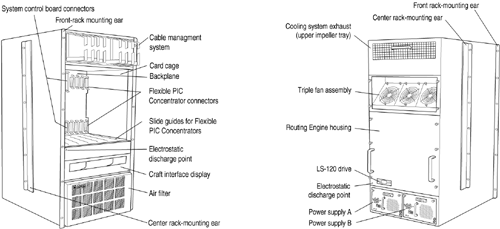M40 Internet Router
| The M40 Internet router (see Figure 3.30) has a maximum aggregate throughput of 12 Gbps. It accepts up to eight FPCs. Table 3.20 shows the physical specifications of the M40 router, and Table 3.21 gives an overview of the major hardware components of the router. Figure 3.30. M40 Internet Router Chassis and Components Table 3.20. M40 Router Physical Specifications
Table 3.21. M40 Internet Router Major Hardware Components
The router chassis includes two front-mounting metal ears, two center-mounting ears, and two ESD points, one front and one rear. The backplane forms the rear of the FPC card cage. The SCB and the FPCs install into the front of the chassis. The backplane contains a temperature sensor and is cooled by three fans. Up to eight FPCs install vertically into the backplane from the front of the chassis, four on either side of the SCB. An FPC can be installed into any FPC slot. Each FPC accepts up to four PICs. The FPCs connect the PICs to the rest of the router so that incoming packets can be forwarded across the backplane to the destination port. The FPCs contain shared memory, which is managed by the Distributed Buffer Manager ASIC on the backplane, for storing data packets received by the PICs. The I/O Manager ASIC on each FPC breaks incoming data packets from the PICs into cells , which are stored in the shared memory buffer, and reassembles them into data packets when they are ready for transmission. When you remove an FPC and install a new one, the backplane flushes the entire system memory pool before the new card is brought online, a process that takes about 200 milliseconds . When you install an FPC into a running system, the Routing Engine downloads the FPC software, the FPC runs its diagnostics, and the PICs on the FPC slot are enabled. Routing functions continue uninterrupted.
The SCB occupies the center slot of the FPC card cage. The SCB is a component of the Packet Forwarding Engine, and performs route lookups, monitoring of system components, transfer of exception and control packets, and control of FPC resets. The components of the SCB include a PowerPC processor, which processes control packets; the Internet Processor ASIC, which performs route lookups; four slots of SSRAM for the forwarding tables; a 19.44-MHz Stratum 3 reference clock for SONET/SDH PICs; and two pairs of LEDs. The M40 router has a single Routing Engine. The Routing Engine installs into the housing on the rear of the router. For more information, see "Routing Engine" on page 37. The craft interface, located on the lower impeller tray on the front of the chassis, allows you to view status and troubleshooting information at a glance and to perform many system control functions (see Figure 3.31). The craft interface contains the system LEDs and buttons , LCD display, alarm relay contacts, and Routing Engine ports. Figure 3.31. M40 Craft Interface The M40 router has two redundant power supplies. A single power supply can provide full power (up to 1500 W) for as long as the system is operational. Redundancy is necessary only in case of power supply failure or removal. The power supplies install at the lower rear of the chassis. The power supplies connect to the backplane, which distributes the different output voltages produced by the power supplies throughout the system and its components. Each power supply contains an integrated fan that cools the power assembly. The M40 router supports both AC and DC power supplies. Table 3.22 lists the specifications for both types. You cannot mix both types of power supply in a single router. Both types are field- replaceable and hot-removable and hot-insertable. Each power supply has a handle for removing the unit from the chassis. Both types have a safety interlock lever that prevents the unit from being removed until the power is cut off. Table 3.22. M40 Router Power Supply Specifications
The M40 router cooling system consists of three separate subsystems: two pairs of redundant impellers that cool the Packet Forwarding Engine; three load-sharing fans that cool the backplane and the Routing Engine; and a built-in fan on each power supply. Each cooling subsystem maintains a separate air flow, and each is monitored independently for temperature control. An air filter at the lower front of the chassis covers all three air intakes. Figure 3.32 shows the air flow through the router and the location of the cooling system components. As the impellers draw air into the front of the card cage through an air filter that covers the air intake vent, they force the exhaust from the rear of the chassis through vents located in the upper impeller tray. The air is channelled past the Packet Forwarding Engine components, keeping them cool. Figure 3.32. Air Flow through the M40 Chassis The fans are load-sharing. If one fan is removed or fails, the other two fans can assume the entire load. The backplane temperature sensor detects temperatures above the acceptable range. A fan failure or excessive temperature condition triggers alarm LEDs on the craft interface and activates alarm relay contacts. Each fan is hot-insertable and hot-removable. Each power supply has its own integrated fan, which cools the power supply. The fan blows air out the exhaust vent at the rear of the chassis, drawing air in through an air filter that covers the air intake vent at the front of the chassis. The cable management system is attached to the chassis and consists of a row of staggered metal hooks, each draped with a rounded plastic shield. This row of hooks is shielded by a removable cable management system cover. The router has LEDs that display the status of various router components. Table 3.23 lists the LEDs on the craft interface and the individual router components. Table 3.23. M40 Router LEDs
| ||||||||||||||||||||||||||||||||||||||||||||||||||||||||||||||||||||||||||||||||||||||||||||||||||||||||||||||||
EAN: 2147483647
Pages: 185


